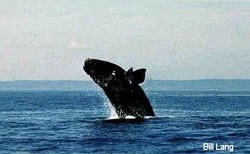Thu, Jan 23, 2003
It's a 'Family Thing'
 Science & Technology International®,
STI, has begun a mission along the northeastern coastline of
Florida to locate and study the behaviors of whales, under a U.S.
Navy contract. STI is using its 200-foot long airship
outfitted with STI's hyperspectral imaging camera system, LASH
(Littoral Airborne Sensor Hyperspectral), to conduct the whale
searches. STI's LASH system detects submerged objects in real time.
STI's camera systems also locate submarines and mines for the U.S.
Navy. This Florida mission is focused on protecting the endangered
North Atlantic Right Whale as well as identifying the migration
patterns of other whales.
Science & Technology International®,
STI, has begun a mission along the northeastern coastline of
Florida to locate and study the behaviors of whales, under a U.S.
Navy contract. STI is using its 200-foot long airship
outfitted with STI's hyperspectral imaging camera system, LASH
(Littoral Airborne Sensor Hyperspectral), to conduct the whale
searches. STI's LASH system detects submerged objects in real time.
STI's camera systems also locate submarines and mines for the U.S.
Navy. This Florida mission is focused on protecting the endangered
North Atlantic Right Whale as well as identifying the migration
patterns of other whales.

"We are honored to take part in this historic and important
mission," said Charlie Hawkins, STI's LASH Airship deputy program
manager. "To our knowledge, hyperspectral imaging has never been
used before to detect whales in Florida. STI and the U.S. Navy will
be providing Florida ocean resource managers valuable information
as to the location and numbers of whales. This data will assist in
protecting Florida's whale population particularly the endangered
North Atlantic Right Whale."
"The Navy is very interested in the safety and welfare of marine
mammals such as the North Atlantic right whale," said Don Statter,
Jr., senior imagery scientist for the U.S. Navy Airship Program.
"We see this as a great opportunity to test passive cameras from a
benign platform to see whales. Our goal is to locate whales,
capture their behavior, plot their location and transmit the
information via digital data link to a ground site."
 "STI's
technology is promising," said Dr. Jim Hain, right whale biologist
and associated scientist at Woods Hole, a non-profit organization.
"Research has shown right whales can only be detected about 30
percent of the time at the surface. The goal is to avoid
ship-strikes against whales. New technologies, like STI's LASH
system combined with an airship, are part of the solution to
protect this endangered species."
"STI's
technology is promising," said Dr. Jim Hain, right whale biologist
and associated scientist at Woods Hole, a non-profit organization.
"Research has shown right whales can only be detected about 30
percent of the time at the surface. The goal is to avoid
ship-strikes against whales. New technologies, like STI's LASH
system combined with an airship, are part of the solution to
protect this endangered species."
More News
Its Offerings Are Lighter, Cleaner, and Now Pushing Past 1,000nm on SAF Jet Fuel DeltaHawk’s diesel-powered aircraft lineup has seen incredible upgrades over the last few yea>[...]
The Airplane Experienced A Total Loss Of Engine Power On December 3, 2025, about 1600 central standard time, a Mooney Aircraft Corp. M20K, N57229, was substantially damaged when it>[...]
Make Sure You NEVER Miss A New Story From Aero-News Network Do you ever feel like you never see posts from a certain person or page on Facebook or Instagram? Here’s how you c>[...]
Aero Linx: European Society of Aerospace Medicine (ESAM) As a pan-European, independent forum, it works to promote the safety and health of all persons involved in aviation and spa>[...]
“We are excited to see Wisk achieve this milestone, and I’m so proud of the team that made it possible. The team at Wisk has built advanced technologies across flight c>[...]
 Aero-TV: DeltaHawks Diesel Power Steps Into the Spotlight
Aero-TV: DeltaHawks Diesel Power Steps Into the Spotlight NTSB Prelim: Mooney Aircraft Corp. M20K
NTSB Prelim: Mooney Aircraft Corp. M20K ANN FAQ: Turn On Post Notifications
ANN FAQ: Turn On Post Notifications ANN's Daily Aero-Linx (12.20.25)
ANN's Daily Aero-Linx (12.20.25) Aero-News: Quote of the Day (12.20.25)
Aero-News: Quote of the Day (12.20.25)





